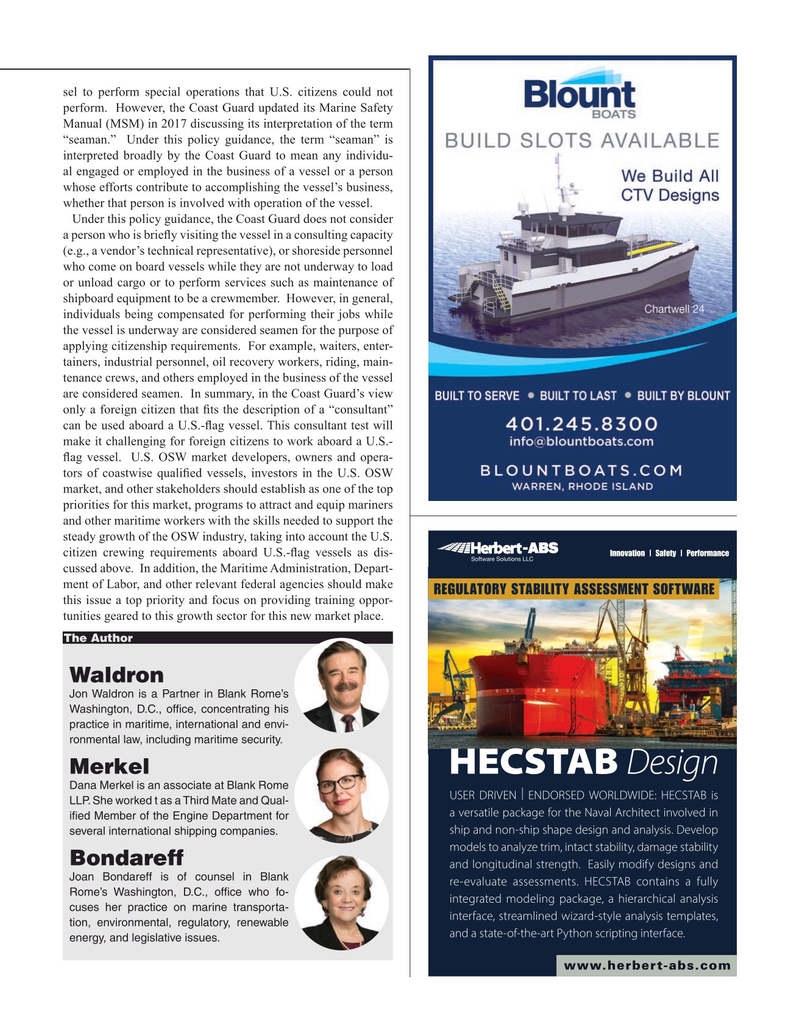
Page 17: of Maritime Reporter Magazine (April 2020)
Offshore Energy Edition
Read this page in Pdf, Flash or Html5 edition of April 2020 Maritime Reporter Magazine
sel to perform special operations that U.S. citizens could not perform. However, the Coast Guard updated its Marine Safety
Manual (MSM) in 2017 discussing its interpretation of the term “seaman.” Under this policy guidance, the term “seaman” is interpreted broadly by the Coast Guard to mean any individu- al engaged or employed in the business of a vessel or a person whose efforts contribute to accomplishing the vessel’s business, whether that person is involved with operation of the vessel.
Under this policy guidance, the Coast Guard does not consider a person who is briefy visiting the vessel in a consulting capacity (e.g., a vendor’s technical representative), or shoreside personnel who come on board vessels while they are not underway to load or unload cargo or to perform services such as maintenance of shipboard equipment to be a crewmember. However, in general, individuals being compensated for performing their jobs while the vessel is underway are considered seamen for the purpose of applying citizenship requirements. For example, waiters, enter- tainers, industrial personnel, oil recovery workers, riding, main- tenance crews, and others employed in the business of the vessel are considered seamen. In summary, in the Coast Guard’s view only a foreign citizen that fts the description of a “consultant” can be used aboard a U.S.-fag vessel. This consultant test will make it challenging for foreign citizens to work aboard a U.S.- fag vessel. U.S. OSW market developers, owners and opera- tors of coastwise qualifed vessels, investors in the U.S. OSW market, and other stakeholders should establish as one of the top priorities for this market, programs to attract and equip mariners and other maritime workers with the skills needed to support the steady growth of the OSW industry, taking into account the U.S.
Innovation | Safety | Performance citizen crewing requirements aboard U.S.-fag vessels as dis- cussed above. In addition, the Maritime Administration, Depart- ment of Labor, and other relevant federal agencies should make
REGULATORY STABILITY ASSESSMENT SOFTWARE this issue a top priority and focus on providing training oppor- tunities geared to this growth sector for this new market place.
The Author
Waldron
Jon Waldron is a Partner in Blank Rome’s
Washington, D.C., offce, concentrating his practice in maritime, international and envi- ronmental law, including maritime security.
HECSTAB Design
Merkel
Dana Merkel is an associate at Blank Rome
USER DRIVEN | ENDORSED WORLDWIDE: HECSTAB is
LLP. She worked t as a Third Mate and Qual- a versatile package for the Naval Architect involved in ifed Member of the Engine Department for ship and non-ship shape design and analysis. Develop several international shipping companies.
models to analyze trim, intact stability, damage stability
Bondareff and longitudinal strength. Easily modify designs and
Joan Bondareff is of counsel in Blank re-evaluate assessments. HECSTAB contains a fully
Rome’s Washington, D.C., offce who fo- integrated modeling package, a hierarchical analysis cuses her practice on marine transporta- interface, streamlined wizard-style analysis templates, tion, environmental, regulatory, renewable and a state-of-the-art Python scripting interface. energy, and legislative issues. www.herbert-abs.com

 16
16

 18
18
